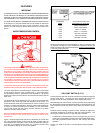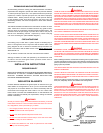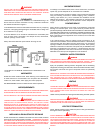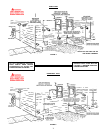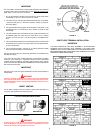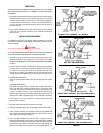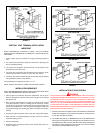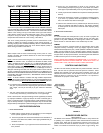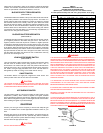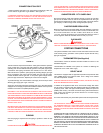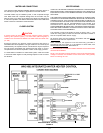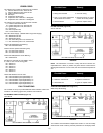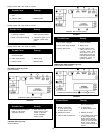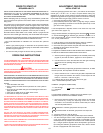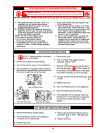
12
tubing must be connected in order for the switch to change the electrical
contacts. The controller requires that the electrical contacts on this air flow
switch be open before it will allow the blower to come on.
BLOCKED OUTLET PROVER SWITCH
(SEE FIGURE 13)
The Blocked Outlet Prover Switch is set up to shut the unit off when a build-
up of positive pressure in the exhaust vent pipe occurs. This switch is a
positive pressure switch that requires an increase in pressure to change
the electrical contacts from normally closed to open. When this switch
prevents the unit from igniting, most likely the exhaust is blocked by some
means Check to see if the condensate is allowed to flow freely from the
exhaust elbow and for obstructions in the exhaust venting and exhaust
vent terminal. Also verify that there is no more than fifty equivalent feet of
three inch PVC vent pipe on the exhaust.
BLOCKED INLET PROVER SWITCH
(SEE FIGURE 13)
The Blocked Inlet Prover Switch is set up to shut the unit off when a build-
up of negative pressure in the intake vent pipe occurs. This switch is a
negative pressure switch that requires an increase in negative pressure
to change the electrical contacts from normally closed to open. The switch
is connected to the pressure tap on the PVC flange connected to the inlet
of the blower. When this switch prevents the unit from igniting, most likely
the intake is blocked by some means. Check to see if there is no more than
fifty equivalent feet of three inch PVC vent pipe on the intake. Also verify
that the intake and intake vent terminal is free of obstructions that may
prevent air from entering the unit.
LOW GAS PRESSURE SWITCH
(SEE FIGURE 13)
The Low Gas Switch (LGS) is a single-pole, normally open pressure switch
that will close its contacts when a rising pressure of 5.0 in. W.C. is
encountered. The contacts will open when the pressure falls below the
fixed set point of 5.0 in. W.C. The LGS monitors the gas supply pressure to
the heater. If the gas supply falls below 5.0 in. W.C., the main burner is
extinguished (if heater is running) or the heater will not start up.
ON/OFF SWITCH
The ON/OFF Switch is a single-pole, single-throw rocker switch. This
switch provides 120V from the line source to the heater.
CAUTION
THE WATER HEATER IS POLARITY SENSITIVE. BEFORE APPLYING
ELECTRICITY TO THIS HEATER BE CERTAIN THAT SUPPLY NEUTRAL WIRE
TO GROUND CHECK INDICATES ZERO VOLTAGE.
HOT SURFACE IGNITER
The Hot Surface Igniter is a device that ignites the main burner by high
temperature (>1800°F). When 120VAC is applied to the igniter, sufficient
heat is generated to ignite the main burner. Although improvements have
been made to strengthen the igniter, it is still fragile and care must be taken
when handling the igniter to prevent breakage.
GAS PIPING
Contact your local gas service company to ensure that adequate gas
service is available and to review applicable installation codes for your
area.
Size the main gas line in accordance with Table 3. The figures shown are
for straight lengths of pipe at 0.5 in. W.C. pressure drop, which is considered
normal for low pressure systems Note that fittings such as elbows and
tees will add to the pipe pressure drop.
CAUTION
DO NOT USE FLEXIBLE GAS PIPING.
TABLE 3
MAXIMUM CAPACITY OF PIPE
IN CUBIC FEET OF GAS PER HOUR
(Based upon a Pressure Drop of 0.5 inch Water Column
and 0.6 Specific Gravity Gas and max. gas pressure of 0.5 psig)
WARNING
THE HEATER IS NOT INTENDED FOR OPERATION AT HIGHER THAN 14.0"
WATER COLUMN (1/2 POUND PER SQUARE INCH) SUPPLY GAS PRESSURE.
HIGHER GAS SUPPLY PRESSURES REQUIRE SUPPLEMENTAL REDUCING
SERVICE REGULATION. EXPOSURE TO HIGHER GAS SUPPLY PRESSURE
MAY CAUSE DAMAGE TO THE GAS CONTROLS WHICH COULD RESULT IN
FIRE OR EXPLOSION. IF OVERPRESSURE HAS OCCURRED SUCH AS
THROUGH IMPROPER TESTING OF GAS LINES OR EMERGENCY
MALFUNCTION OF THE SUPPLY SYSTEM THE GAS VALVE MUST BE
CHECKED FOR SAFE OPERATION. MAKE SURE THAT THE OUTSIDE VENTS
ON THE SUPPLY REGULATORS AND THE SAFETY VENT VALVES ARE
PROTECTED AGAINST BLOCKAGE. THESE ARE PARTS OF THE GAS
SUPPLY SYSTEM, NOT THE HEATER. VENT BLOCKAGE MAY OCCUR
DURING ICE STORMS.
IT IS IMPORTANT TO GUARD AGAINST GAS VALVE FOULING FROM
CONTAMINANTS IN THE GAS WAYS. SUCH FOULING MAY CAUSE
IMPROPER OPERATION, FIRE OR EXPLOSION.
IF COPPER SUPPLY LINES ARE USED THEY MUST BE INTERNALLY TINNED
AND CERTIFIED FOR GAS SERVICE.
BEFORE ATTACHING THE GAS LINE BE SURE THAT ALL GAS PIPE IS
CLEAN ON THE INSIDE.
TO TRAP ANY DIRT OR FOREIGN MATERIAL IN THE GAS SUPPLY LINE, A
DIRT LEG (SOMETIMES CALLED A SEDIMENT TRAP OR DRIP LEG) MUST
BE INCORPORATED IN THE PIPING (SEE FIG. 14). THE DIRT LEG MUST BE
READILY ACCESSIBLE AND NOT SUBJECT TO FREEZING CONDITIONS.
INSTALL IN ACCORDANCE WITH RECOMMENDATIONS OF SERVING GAS
SUPPLIERS. REFER TO THE NATIONAL FUEL GAS CODE.
FIGURE 14
Length NOMINAL IRON PIPE SIZES, INCHES
in Feet 1/2" 3/4" 1" 1 1/4" 1 1/2" 2" 2 1/2" 3" 4"
10 175 360 680 1,400 2,100 3,950 6,300 11,000 23,000
20 120 250 465 950 1,460 2,750 4,350 7,700 15,800
30 97 200 375 770 1,180 2,200 3,520 6,250 12,800
40 82 170 320 660 990 1,900 3,000 5,300 10,900
50 73 151 285 580 900 1,680 2,650 4,750 9,700
60 66 138 260 530 810 1,520 2,400 4,300 8,800
70 61 125 240 490 750 1,400 2,250 3,900 8,100
80 57 118 220 460 690 1,300 2,050 3,700 7,500
90 53 110 205 430 650 1,220 1,950 3,450 7,200
100 50 103 195 400 620 1,150 1,850 3,250 6,700
125 44 93 175 360 550 1,020 1,650 2,950 6,000
150 40 84 160 325 500 950 1,500 2,650 5,500
175 37 377 145 300 460 850 1,370 2,450 5,000
200 36 72 135 280 430 800 1,280 2,280 4,600



